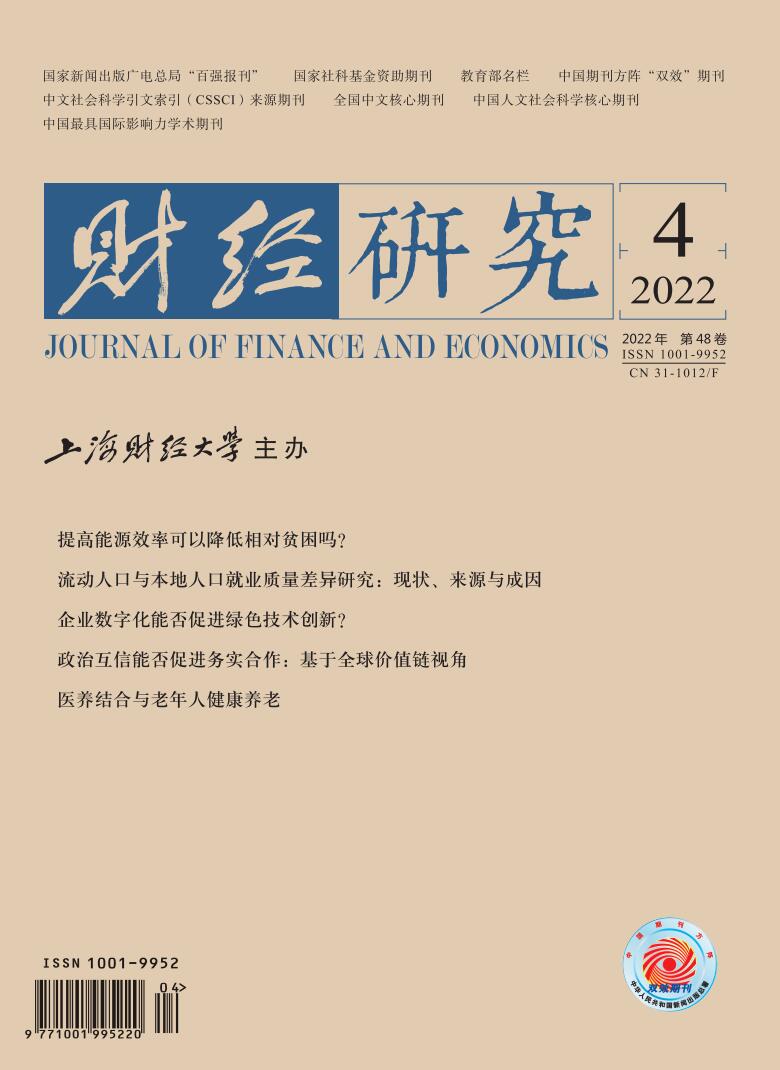作为一种逐步兴起的新型政策手段,自愿性环境规制能否更好地平衡环境保护和经济增长,是值得深入研究的重要问题。文章利用中国工业企业数据、工业企业污染排放数据和政府节能采购企业清单,通过构建双重差分模型,实证检验了政府节能采购政策对企业污染排放的影响。研究发现,政府节能采购政策实施后,实验组的二氧化硫排放量相对于对照组显著降低,说明政府节能采购政策抑制了企业污染排放。经过多种稳健性检验,这一结论依然成立。机制检验表明,政府节能采购政策通过严格约束生产的各个环节,抑制了企业污染排放,具体包括在生产初始阶段改善能源结构、在生产过程中创新生产技术以及在生产终端提高污染处理能力。异质性检验表明,由于打破了原有的政企合谋氛围,政府节能采购政策使国有企业的污染减排效果更明显;此外,这一政策还赋予了企业更多的自主权,使得低污染排放强度企业的污染减排效果更明显。同时,在减少企业污染排放的同时,政府节能采购政策还提高了企业产量和绿色全要素生产率。文章研究表明,自愿性环境规制能够较好地平衡环境保护和经济增长,为经济高质量发展阶段政府制定有效的环境政策提供了有益的启示。
自愿性环境规制与企业污染排放——基于政府节能采购政策的实证检验
摘要
参考文献
1 陈登科. 贸易壁垒下降与环境污染改善−来自中国企业污染数据的新证据[J]. 经济研究,2020,(12):98−114.
2 韩超,陈震,王震. 节能目标约束下企业污染减排效应的机制研究[J]. 中国工业经济,2020,(10):43−61. DOI:10.3969/j.issn.1006-480X.2020.10.003
4 蒋为. 环境规制是否影响了中国制造业企业研发创新?−基于微观数据的实证研究[J]. 财经研究,2015,(2):76−87. DOI:10.16538/j.cnki.jfe.2015.02.003
7 李欣,顾振华,徐雨婧. 公众环境诉求对企业污染排放的影响−来自百度环境搜索的微观证据[J]. 财经研究,2022,(1):34−48. DOI:10.16538/j.cnki.jfe.20211016.302
9 马小明,赵月炜. 环境管制政策的局限性与变革−自愿性环境政策的兴起[J]. 中国人口·资源与环境,2005,(6):19−23. DOI:10.3969/j.issn.1002-2104.2005.06.005
19 王勇. 自愿性环境协议在我国应用之必要性证成−一种政府规制的视角[J]. 生态经济,2016,(9):145−151. DOI:10.3969/j.issn.1671-4407.2016.09.030
21 曾义,冯展斌,张茜. 地理位置、环境规制与企业创新转型[J]. 财经研究,2016,(9):87−98. DOI:10.16538/j.cnki.jfe.2016.09.008
22 张彩云,郭艳青. 污染产业转移能够实现经济和环境双赢吗?−基于环境规制视角的研究[J]. 财经研究,2015,(10):96−108. DOI:10.16538/j.cnki.jfe.2015.10.001
23 张彩云,苏丹妮,卢玲,等. 政绩考核与环境治理−基于地方政府间策略互动的视角[J]. 财经研究,2018,(5):4−22. DOI:10.16538/j.cnki.jfe.2018.05.001
24 张红凤. 制约、双赢到不确定性−环境规制与企业竞争力相关性研究的演进与借鉴[J]. 财经研究,2008,(7):17−27. DOI:10.16538/j.cnki.jfe.2008.07.007
27 赵玉民,朱方明,贺立龙. 环境规制的界定、分类与演进研究[J]. 中国人口·资源与环境,2009,(6):85−90. DOI:10.3969/j.issn.1002-2104.2009.06.016
29 Aghion P, Dechezleprêtre A, Hémous D, et al. Carbon taxes, path dependency, and directed technical change: Evi- dence from the auto industry[J]. Journal of Political Economy,2016,124(1): 1−51. DOI:10.1086/684581
30 Bansal P, Hunter T. Strategic explanations for the early adoption of ISO 14001[J]. Journal of Business Ethics,2003,46(3): 289−299. DOI:10.1023/A:1025536731830
31 Blackman A, Lahiri B, Pizer W, et al. Voluntary environmental regulation in developing countries: Mexico’s clean industry program[J]. Journal of Environmental Economics and Management,2010,60(3): 182−192. DOI:10.1016/j.jeem.2010.05.006
32 Brandt L, Van Biesebroeck J, Zhang Y F. Creative accounting or creative destruction? Firm-level productivity growth in Chinese manufacturing[J]. Journal of Development Economics,2012,97(2): 339−351. DOI:10.1016/j.jdeveco.2011.02.002
33 Bu M L, Qiao Z Z, Liu B B. Voluntary environmental regulation and firm innovation in China[J]. Economic Modelling,2020,89: 10−18. DOI:10.1016/j.econmod.2019.12.020
34 Jacobson L S, LaLonde R J, Sullivan D G. Earnings losses of displaced workers[J]. The American Economic Review,1993,83(4): 685−709.
35 Jaffe A B, Newell R G, Stavins R N. Technological change and the environment[A]. Mäler K G, Vincent J R. Handbook of environmental economics[M]. Amsterdam: Elsevier, 2003.
36 Jiménez O. Innovation-oriented environmental regulations: Direct versus indirect regulations; an empirical analysis of small and medium-sized enterprises in Chile[J]. Environment and Planning A: Economy and Space,2005,37(4): 723−750. DOI:10.1068/a3736
37 Katila R, Ahuja G. Something old, something new: A longitudinal study of search behavior and new product introduction[J]. Academy of Management Journal,2002,45(6): 1183−1194.
38 La Ferrara E, Chong A, Duryea S. Soap operas and fertility: Evidence from Brazil[J]. American Economic Journal: Applied Economics,2012,4(4): 1−31. DOI:10.1257/app.4.4.1
39 Lee E. Environmental regulation and financial performance in China: An integrated view of the porter hypothesis and institutional theory[J]. Sustainability,2020,12(23): 10183. DOI:10.3390/su122310183
40 Lin H, Zeng S X, Wang L Y, et al. How does environmental irresponsibility impair corporate reputation? A multi-method investigation[J]. Corporate Social Responsibility and Environmental Management,2016,23(6): 413−423. DOI:10.1002/csr.1387
41 Mbanyele W, Wang F R. Environmental regulation and technological innovation: Evidence from China[J]. Environmental Science and Pollution Research,2021,29(9): 12890−12910.
42 Mizobuchi K. An empirical study on the rebound effect considering capital costs[J]. Energy Economics,2008,30(5): 2486−2516. DOI:10.1016/j.eneco.2008.01.001
43 Nie X, Wu J X, Chen Z P, et al. Can environmental regulation stimulate the regional Porter effect? Double test from quasi-experiment and dynamic panel data models[J]. Journal of Cleaner Production,2021,314: 128027. DOI:10.1016/j.jclepro.2021.128027
44 Okushima S, Tamura M. What causes the change in energy demand in the economy? The role of technological change[J]. Energy Economics,2010,32(S1): S41−S46.
45 Papa M. The voluntary environmentalists: Green clubs, ISO 14001, and voluntary environmental regulations[J]. Global Environmental Politics,2008,8(2): 156−158. DOI:10.1162/glep.2008.8.2.156
46 Popp D. Induced innovation and energy prices[J]. American Economic Review,2002,92(1): 160−180. DOI:10.1257/000282802760015658
47 Porter M E, Van der Linde C. Green and competitive: Ending the stalemate[J]. Harvard Business Review,1995,73(5): 33.
48 Prakash A, Potoski M. Global private regimes, domestic public law: ISO 14001 and pollution reduction[J]. Compara- tive Political Studies,2014,47(3): 369−394. DOI:10.1177/0010414013509573
49 Qi G Y, Zeng S X, Li X D, et al. Role of internalization process in defining the relationship between ISO14001 certifica- tion and corporate environmental performance[J]. Corporate Social Responsibility and Environmental Management,2012,19(3): 129−140. DOI:10.1002/csr.258
50 Ranocchia C, Lambertini L. Porter hypothesis vs pollution haven hypothesis: Can there be environmental policies getting two eggs in one basket?[J]. Environmental and Resource Economics,2021,78(1): 177−199. DOI:10.1007/s10640-020-00533-x
51 Rennings K. Redefining innovation: Eco-innovation research and the contribution from ecological economics[J]. Ecological Economics,2000,32(2): 319−332. DOI:10.1016/S0921-8009(99)00112-3
52 Rosenbaum P R, Rubin D B. Constructing a control group using multivariate matched sampling methods that incorporate the propensity score[J]. The American Statistician,1985,39(1): 33−38.
53 Shin S. The role of the government in voluntary environmental protection schemes: The case of ISO 14001 in China[J]. Issues & Studies,2005,41(4): 141−173.
54 Shu C L, Zhou K Z, Xiao Y Z, et al. How green management influences product innovation in China: The role of institutional benefits[J]. Journal of Business Ethics,2016,133(3): 471−485. DOI:10.1007/s10551-014-2401-7
55 Stucki T, Woerter M, Arvanitis S, et al. How different policy instruments affect green product innovation: A differentiated perspective[J]. Energy Policy,2018,114: 245−261. DOI:10.1016/j.enpol.2017.11.049
56 Tone K, Tsutsui M. Dynamic DEA: A slacks-based measure approach[J]. Omega,2010,38(3−4): 145−156. DOI:10.1016/j.omega.2009.07.003
57 Yang M, Yuan Y N, Yang F X, et al. Effects of environmental regulation on firm entry and exit and China’s industrial productivity: A new perspective on the Porter hypothesis[J]. Environmental Economics and Policy Studies,2021,23(4): 915−944. DOI:10.1007/s10018-021-00310-0
58 Zeng S X, Tam C M, Tam V W Y, et al. Towards implementation of ISO 14001 environmental management systems in selected industries in China[J]. Journal of Cleaner Production,2005,13(7): 645−656. DOI:10.1016/j.jclepro.2003.12.009
引用本文
步晓宁, 赵丽华. 自愿性环境规制与企业污染排放——基于政府节能采购政策的实证检验[J]. 财经研究, 2022, 48(4): 49-63.
导出参考文献,格式为:





 4214
4214  4390
4390

